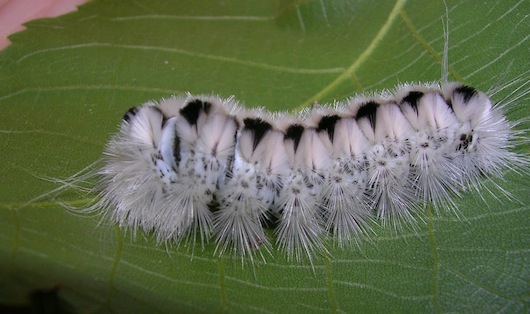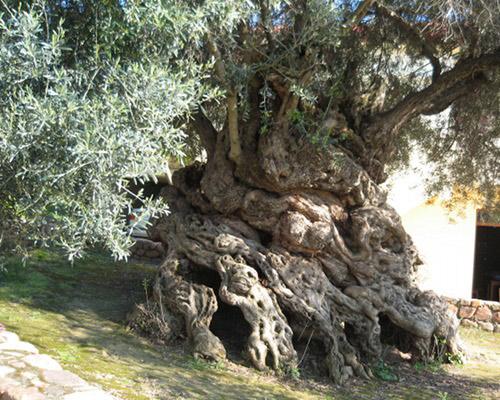Caterpillars are high in protein and rather defenseless — making them an easy dinner staple for other animals — and many have evolved various means of protection. Their markings and body parts can make them seem larger in size or even poisonous. In fact, some of them are poisonous, both to consume and to the touch.
But before you go out and start squishing caterpillars, remember that they are not vicious and stinging only occurs when they are touched and feel threatened.
Somebody needs a haircut — but then somebody would be much less dangerous and not nearly as cute. The larvae of the pine processionary moth could be the model for caterpillar shampoo if there were such a thing.
But all that hair, touchable as it may look, should never be touched. Not only are the extremely irritating hairs harpoon-shaped, but the caterpillar can eject them when threatened, at which point they penetrate all areas of exposed skin, replete with urticating venom.
Question: Cute fuzzy octopus monster that could be a plush toy? Or, an arachnophobe’s worst nightmare?
Whichever camp you’re in, one thing’s for sure: there’s little mystery as to why this caterpillar garnered its nickname, the “monkey slug.”
Complete with six pairs of curly projections densely covered in hairs — the “limbs” can fall off without harming the larvae, but the hairs can cause some fierce irritation.
Taking the prize for “Caterpillar Most Resembling a Chinese New Year Dragon,” the cute and beautiful saddleback caterpillar is native to eastern North America, although it looks better suited for much more exotic climes.
The pert pompoms these caterpillars sport are more than decorative. Like much of the rest of this creature's body, the pompoms bear urticating hairs that secrete irritating venom. The stings are very painful, and they can cause swelling, nausea, and leave a rash that can last for days.
Nature got it right with this one — it's designed it to look as scary as it is. This is not the caterpillar you want to meet in a dark alley. Known as the “assassin caterpillar,” the South American larvae are responsible for at least 500 deaths, and probably many more.
The spear-like bristles penetrate the skin and deliver a dose of toxin which leads to headache, fever, vomiting and malaise before a severe bleeding disorder ensues leading to ecchymosis, hematuria, pulmonary and intracranial hemorrhages (yes, that's blood flooding the brain), and acute renal failure.
Animal, vegetable, mineral ... caterpillar! Like a tiny oasis of palm trees, the sweet, colorful io moth caterpillar has a broad range, from Manitoba and in the southern extremes of Ontario, Quebec, and New Brunswick in Canada, to Montana, North Dakota, South Dakota, Nebraska, Colorado, New Mexico, Texas, Utah, east of those states and down to the southern end of Florida. Io gets around.
And yes, those frond-like spines have a painful venom that is released with the slightest touch. Some people experience severe reactions and require medical attention, while some only itch or have a burning sensation.
The Cousin Itt of caterpillars, this guy (pictured above) goes by the name of puss caterpillar or asp — and both names make sense. Puss, because this total cutie pie is as fuzzy as a kitty; and asp, as in snake, because this is one of the most toxic caterpillars in North America.
The venom comes from poisonous spines neatly concealed by the irresistibly fuzzy surface. When touched, the spines break off and lodge in the skin, releasing the venom. Mother Nature at her sneakiest. According to the toxin library of the American Association of Clinical Chemistry (AACC), this is no simple sting: Intense throbbing pain develops within five minutes of contact, with pain extending up the affected arm. Other symptoms may include headaches, nausea, vomiting, intense abdominal distress, lymphadenopathy, lymphadenitis, and sometimes shock or respiratory stress.
This caterpillar that’s reminiscent of an angora sweater can indeed pack a punch — the bristles are capable of inducing a frightful case of urticaria.
Such elegance! Dapper, with its velvety back and sweeping bristles, this creature looks more vintage feather boa than larva — but larva it is. And stinging larva, at that. Although some people have little to no reaction to this caterpillar, others have a reaction that ranges from a mild to a fairly severe rash comparable to poison ivy.
In case of stings
Should you get stung by a caterpillar, Poison Information Center recommends this treatment: Place Scotch tape over the affected area and strip off repeatedly to remove spines. Apply ice packs to reduce the stinging sensation, and follow with a paste of baking soda and water. If the victim has a history of hay fever, asthma or allergy, or if allergic reactions develop, contact a physician immediately.
But before you go out and start squishing caterpillars, remember that they are not vicious and stinging only occurs when they are touched and feel threatened.
 |
| Pine processionary caterpillar (Thaumetopoea pityocampa) |
Somebody needs a haircut — but then somebody would be much less dangerous and not nearly as cute. The larvae of the pine processionary moth could be the model for caterpillar shampoo if there were such a thing.
But all that hair, touchable as it may look, should never be touched. Not only are the extremely irritating hairs harpoon-shaped, but the caterpillar can eject them when threatened, at which point they penetrate all areas of exposed skin, replete with urticating venom.
 |
| Hag moth caterpillar (Phobetron pithecium) |
Question: Cute fuzzy octopus monster that could be a plush toy? Or, an arachnophobe’s worst nightmare?
Whichever camp you’re in, one thing’s for sure: there’s little mystery as to why this caterpillar garnered its nickname, the “monkey slug.”
Complete with six pairs of curly projections densely covered in hairs — the “limbs” can fall off without harming the larvae, but the hairs can cause some fierce irritation.
 |
| Saddleback caterpillar (Acharia stimulea) |
Taking the prize for “Caterpillar Most Resembling a Chinese New Year Dragon,” the cute and beautiful saddleback caterpillar is native to eastern North America, although it looks better suited for much more exotic climes.
The pert pompoms these caterpillars sport are more than decorative. Like much of the rest of this creature's body, the pompoms bear urticating hairs that secrete irritating venom. The stings are very painful, and they can cause swelling, nausea, and leave a rash that can last for days.
 |
| Giant silkworm moth caterpillar (Lonomia oblique) |
Nature got it right with this one — it's designed it to look as scary as it is. This is not the caterpillar you want to meet in a dark alley. Known as the “assassin caterpillar,” the South American larvae are responsible for at least 500 deaths, and probably many more.
The spear-like bristles penetrate the skin and deliver a dose of toxin which leads to headache, fever, vomiting and malaise before a severe bleeding disorder ensues leading to ecchymosis, hematuria, pulmonary and intracranial hemorrhages (yes, that's blood flooding the brain), and acute renal failure.
 |
| Io moth caterpillar (Automeris io) |
And yes, those frond-like spines have a painful venom that is released with the slightest touch. Some people experience severe reactions and require medical attention, while some only itch or have a burning sensation.
 |
| Puss caterpillar (Megalopyge opercularis) |
The Cousin Itt of caterpillars, this guy (pictured above) goes by the name of puss caterpillar or asp — and both names make sense. Puss, because this total cutie pie is as fuzzy as a kitty; and asp, as in snake, because this is one of the most toxic caterpillars in North America.
The venom comes from poisonous spines neatly concealed by the irresistibly fuzzy surface. When touched, the spines break off and lodge in the skin, releasing the venom. Mother Nature at her sneakiest. According to the toxin library of the American Association of Clinical Chemistry (AACC), this is no simple sting: Intense throbbing pain develops within five minutes of contact, with pain extending up the affected arm. Other symptoms may include headaches, nausea, vomiting, intense abdominal distress, lymphadenopathy, lymphadenitis, and sometimes shock or respiratory stress.
_1.jpg) |
| White cedar moth caterpillar (Leptocneria reducta) |
As described by the Coff’s Harbour Butterfly House, by day the white cedar moth caterpillar “hides in crevices on or near the ground. In the gloom of an evening, they swarm as a seething mass of hundreds of hairy brown bodies, undulating in eerie silent flow up the tree trunk and along the branches to the leaves, which they eat voraciously … when a tree becomes defoliated, they wander everywhere looking for another one.”
This caterpillar that’s reminiscent of an angora sweater can indeed pack a punch — the bristles are capable of inducing a frightful case of urticaria.
 |
| Hickory tussock caterpillar (Lophocampa caryae) |
Such elegance! Dapper, with its velvety back and sweeping bristles, this creature looks more vintage feather boa than larva — but larva it is. And stinging larva, at that. Although some people have little to no reaction to this caterpillar, others have a reaction that ranges from a mild to a fairly severe rash comparable to poison ivy.
In case of stings
Should you get stung by a caterpillar, Poison Information Center recommends this treatment: Place Scotch tape over the affected area and strip off repeatedly to remove spines. Apply ice packs to reduce the stinging sensation, and follow with a paste of baking soda and water. If the victim has a history of hay fever, asthma or allergy, or if allergic reactions develop, contact a physician immediately.














 //PART 2
//PART 2